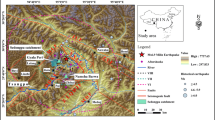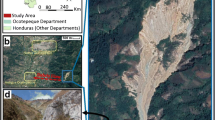Abstract
Landslides and rock avalanches triggered by the 2008 Wenchuan Earthquake produced 257 landslide dams, mainly situated along the eastern boundary of the Qinghai-Tibet Plateau where rivers descend approximately 3,000 m into the Sichuan Basin. The largest of these dams blocked the Tongkou River (a tributary of the Fujiang River) at Tangjiashan. The blockage, consisting of 2.04 × 107 m3 of landslide debris, impounded a lake with a projected maximum volume of 3.15 × 108 m3, potentially inundating 8.92 km2 of terrain. Its creation during the rainy season and the possibility of an uncontrolled release posed a serious, impending threat to at least 1.3 million people downstream that could add substantially to the total of 69,200 individuals directly killed by the earthquake. Risk assessment of the blockage indicated that it was unlikely to collapse suddenly, and that eventual overtopping could be mitigated by notching the structure in order to create an engineered breach and achieve safe drainage of the lake. In addition to the installation of monitoring and warning instrumentation, for emergency planning we estimated several outburst scenarios equivalent to 20, 25, 33, and 50% of the dam failing suddenly, creating, respectively, 3.35, 3.84, 4.22, and 4.65 km2 of flooded area, and overbank water depths of 4.6, 5.1, 5.7, and 6.2 m, respectively, in Mianyang, the second largest city in Sichuan Province, 48 km downstream from the blockage. Based on these scenarios, recommendations and plans for excavating a sluiceway, draining the lake, and downstream evacuation were proposed and later were implemented successfully, with the blockage breached by overtopping on June 10, less than a month after dam emplacement. The peak discharge of the release only slightly exceeded the flood of record at Mianyang City. No lives were lost, and significant property damage was avoided. Post-breaching evaluation reveals how future similar mitigation can be improved. Although initial breach erosion was slow, later erosion was judged uncontrollably rapid; increased slope of the engineered channel and adoption of a compound, trapezoid–triangular cross-section can be considered, as can other measures to control the rate of breach incision. Evacuees from Mianyang City spent an unnecessarily long time (12 days) in temporary settlements; more precise risk management planning can reduce this time in the future.











Similar content being viewed by others
References
Chai HJ, Liu HC, Zhang ZY (2000) The temporal-spatial distribution of damming landslides in China. J Mt Sci 18(supp):51–54 (in Chinese)
Chen JC, Fan KX, Li ZP et al (2008a) An analysis of hydrological characteristics of Tangjiashan landslide lake. Yangtze River 39(22):26–28 (in Chinese)
Chen WY, Zheng JX, Tan J et al (2008b) The proposals of emergency and comprehensive treatment for Tangjiashan Barrier Lake. China Power 34(11):10–14 (in Chinese)
Costa JE (1985) Floods from dam failures. U.S. Geological Survey Open-File Report 85-560
Costa JE, Schuster RI (1988) The formation and failure of natural dams. Geol Soc Am Bull 100:1054–1068
Cui P, Zhu YY, Han YS et al (2009) The 12 May 2008 Wenchuan Earthquake lakes: distribution and risk evaluation. Landslides 6:209–223
Dai FC, Lee CF, Deng JH et al (2006) The 1786 earthquake-triggered landslide dam and subsequent dam-break flood on the Dadu River, southwestern China. Geomorphology 73:277–278
Ermini L, Casagli N (2003) Prediction of the behavior of landslide dams using a geomorphological dimensionless index. Earth Surf Proc Land 28:31–47
Fread DL (1977) The development and testing of a dam-break flood forecasting model. In: Proceedings of dam-break flood routing model workshop in Bethesda, Water Resources Council, Washington, D.C., pp 164–197
Fread DL (1980) Capabilities of NWS model to forecast flash floods caused by dam failures. In: Proceedings of second conference on flash floods, American Meteorological Society, Boston, MA, pp 171–178
Fread DL (1988) BREACH: an erosion model for earthen dam failures (Revision 1991), National Weather Service (NWS) Report, NOAA, Silver Spring MA
Froehlich DC (1995) Peak outflow from breached embankment dam. J Water Resour Plan Manag ASCE 121(1):90–97
Harrison A (1974) Madison Canyon slide mass modification by the US Army Corps of Engineers. In: Voight B (ed) The 3rd Proceedings of international congress on rock mechanics, Pennsylvania State University College of Earth Sciences Experiment Station Special Publication, pp 138–143
Hydrology office of Sichuan Province (1979) Hydrological manual of Sichuan Province. Sichuan Science and Technique House, Chengdu (in Chinese)
Kirkpatrick GA (1977) Evaluation guidelines for spillway adequacy, In: Proceedings of the engineering foundation conference, American Society of Civil Engineers, New York, pp 395–414
Li W (1980) Handbook of hydraulic calculations. Water Publication, Beijing (in Chinese)
Liu N, Yang QG (2009) The emergency handling technique and practice of Tangjiashan barrier lake. China Eng Sci 11(6):74–81 (in Chinese)
Ma GS, Luo XJ (2008) Formation mechanism of Tangjiashan landslide and engineer geological characters of the dam. Yangtze River 39(22):46–47 (in Chinese)
Singh VP (1996) Dam breach modeling technology. Kluwer Academic Publishers, Dordrecht, The Netherlands
Xu XW, Wen XZ, Ye JQ et al (2008) The MS 8.0 Wenchuan Earthquake surface ruptures and its seismogenic structure. Seismol Geol 30(3):597–629 (in Chinese)
Yang QG (2008) Key technologies of emergency treatment of Tangjiashan dammed lake. China Water Resour 16:8–11 (in Chinese)
Yi GX, Wen XZ, Wang SW et al (2006) Study on fault sliding behaviors and strong-earthquake risk of the Longmenshan-Minshan Fault Zones from current seismicity parameters. Earthq Res China 22(2):117–125
Zhao ZX, He JJ (2005) Hydraulics. Tsinghua University Press, Beijing (in Chinese)
Acknowledgments
The work was supported by the State Key Fundamental Research Program (project 2008CB425802), and the Knowledge Innovation Project of the Chinese Academy of Sciences (project KZCX2-YW-302). The authors acknowledge Prof. Liu Ning, Ministry of Land and Resources, Water Resources Bureau, Mianyang City, for providing photographs.
Author information
Authors and Affiliations
Corresponding author
Rights and permissions
About this article
Cite this article
Cui, P., Dang, C., Zhuang, Jq. et al. Landslide-dammed lake at Tangjiashan, Sichuan province, China (triggered by the Wenchuan Earthquake, May 12, 2008): risk assessment, mitigation strategy, and lessons learned. Environ Earth Sci 65, 1055–1065 (2012). https://doi.org/10.1007/s12665-010-0749-2
Received:
Accepted:
Published:
Issue Date:
DOI: https://doi.org/10.1007/s12665-010-0749-2




